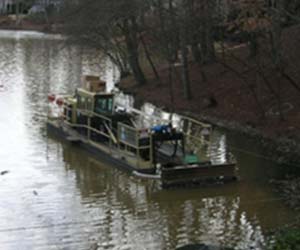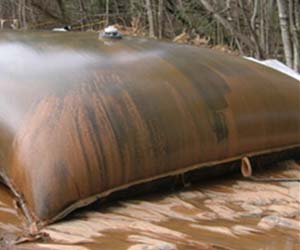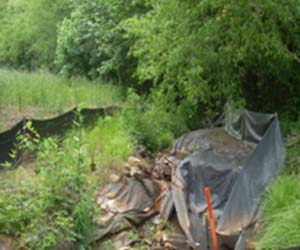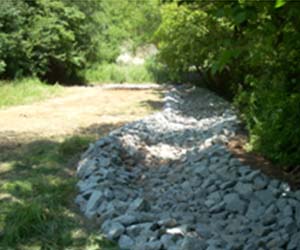Haight Davis & Associates, Inc. was hired by the Brooke Farm HOA to design, plan and manage the dredging of their subdivision lake. In addition, the project was to include the appropriate measures to minimize the amount of sedimentation introduced to the lake in the future years. Thus, a two-pronged approach was implemented. The first phase was the dredging of the lake, followed by the reconstruction of the main drainage channel which drained into the lake.
Access to the shoreline was limited and the homeowners did not want trucks or other construction equipment in and out of their neighborhood. HDA was tasked with finding a resolution to the problem, meeting with potential contractors and managing the project from start to finish. Approximately 2,220 cubic yards of sediment needed to be removed from the lake.

Floating Barge

Geotube Filled with Sediment
Geotube® filled with sediment. HDA recommended using a floating barge equipped with an auger and cutter-head to agitate and collect the sediment, and a pump to discharge the sediment from the Brooke Farm Lake to the spoils area. The discharge was transported via floating-pipeline running through a subsurface culvert. The spoils area was on property owned by the Brooke Farm Homeowners Association, but was located in a Colonial Pipeline easement. This required expressed permission and on-site supervision by a Colonial Pipeline Right of Way Inspector in order to conduct operations in the easement area. The discharge was stored in Geotextile Tubes (Geotube®), which retains fill material while allowing water to permeate through the tube wall. The Geotubes dried out over a period of 4 months and the material was later dispersed throughout the Pipeline easement area.
The second phase of the project involved the redesign and reconstruction of the drainage channel from the adjacent community of Brooke Ridge, to the lake. The continuously-flowing stream crossed over the Colonial Pipeline easement and required continued supervision by the Colonial Pipeline Right of Way Inspectors. The work consisted of temporarily pumping the stream water, re-grading and widening the existing channel, and installing fabric and riprap on the banks and in the bed of the drainage channel.

Drainage Before Repairs



